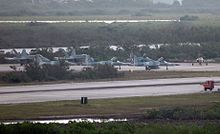Naval air station
A naval air station is a
The term "Naval Air Station" is used by many countries' navies, such as the United States Navy, the Royal Australian Navy, the Royal Navy, and the Indian Navy.
In the case of the U.S. Navy, similar facilities in the
The
The Argentine Naval Prefecture, serving as the Coast Guard, also operates air stations at Posadas, Buenos Aires, Mar del Plata, and Comodoro Rivadavia. Aircraft operating out of these bases are heavily involved in air/sea rescues.[1][2]
This section needs expansion. You can help by adding to it. (May 2008) |
In
In 2017, the French Naval Aviation has four naval air stations (BAN), all located in metropolitan territory.
- BAN Lann-Bihoué (mainly dedicated to maritime patrol)
- BAN Lanvéoc-Poulmic (mainly dedicated to helicopters)
- BAN Landivisiau (mainly dedicated to carrier fighters)
- BAN Hyères Le Palyvestre, (mainly dedicated to carrier fighters)
Location

In 2011, the BAN Tontouta was reassigned the French Air Force ; the BAN Nîmes-Garons is now assigned primarily to the civil aviation (air transport) and on a secondary basis to the Ministry of Interior for Civil Security.
This section needs expansion. You can help by adding to it. (May 2008) |
The
Until 2006, the former served as the main operating base for the Royal Navy's Sea Harriers, which were based upon the three
The
.In the United States, a "Naval Air Station" (NAS) is an air base of the United States Navy. When located in foreign countries, they are more specifically named US Naval Air Stations (USNAS), to avoid confusion with naval air stations used by the navies of the host countries.
A slightly lower level of air base in the U.S. Navy is the Naval Air Facility.[

There are also a number of former Naval Air Stations that have been realigned as part of larger Naval Stations (NAVSTA) or redesignated to other functions in the Navy.[
There are also larger facilities that are similar to Naval Air Stations and possess large airfield facilities, but were actually constructed as part of much larger facilities or were dedicated to research and development activities. This includes NAVSTA Rota, Spain; the recently closed NAVSTA Roosevelt Roads, Puerto Rico; the still active Naval Air Weapons Station (NAWS) China Lake, California; and the recently closed Naval Air Warfare Center Warminster, Pennsylvania.
The Navy also operates a number of austere unstaffed or minimally staffed airfields known as Naval Auxiliary Landing Fields (NALF),
United States Marine Corps
In the United States, a "Marine Corps Air Station" is an air base of the United States Marine Corps. When located in foreign countries, they are often identified as US Marine Corps Air Stations (USMCAS), following their US Navy counterparts (the Marine Corps falling as a service under the Department of the Navy) as that term is used by the navies of other countries.
As part of Naval Aviation,
Like the Navy, the Marine Corps also operates a number of austere unstaffed or minimally staffed airfields known as Marine Corps Auxiliary Landing Fields (MCALF), Marine Corps Outlying Landing Fields (MCOLF), or more simply Outlying Fields (OLF). Since the Marines' flight training is combined with the Navy and the Coast Guard, those fields dedicated to training of student aviators in the southeastern United States remain under Navy control. As a result, the Marine Corps' auxiliary fields support operational Fleet Marine Force (FMF) units for readiness purposes, such as field carrier landing practice (FCLP) for fixed-wing and rotary-wing aircraft embarking on aircraft carriers or amphibious assault ships.
United States Coast Guard
The United States Coast Guard is also part of U.S. Naval Aviation and operates its own Coast Guard Air Stations and Coast Guard Air Facilities, either as stand alone installations on joint civil-military airports or Coast Guard-controlled facilities, or collocated at Naval Air Stations, Air Force Bases, Air National Guard Bases and Army Air Fields. Since the Coast Guard has no aviation facilities located in foreign countries, the service tends not use the term "U.S. Coast Guard Air Station" (USCGAS), but will use the term Coast Guard Air Station (CGAS) or more simply, "AIRSTA." The Coast Guard also operates a number of smaller Coast Guard Air Facilities, most of which are limited to rotary-wing operations only and support a limited number of aircraft and personnel.
See also
- Lists of military installations
- Naval air squadron (also abbreviated NAS)
- NAWS, Naval Air Weapons Station China Lake, California, United States
- Naval outlying landing field
